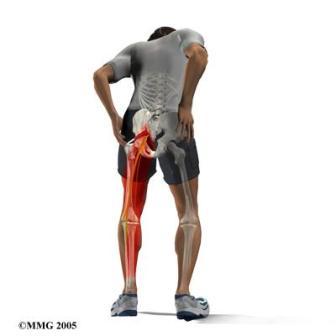Athletic Injury Update: Sciatic Pain From Piriformis Syndrome
Yes, sciatica can affect athletes of all ages, not just the middle-aged or elderly populations. Sciatica is known to most people as a pinched nerve in the low back, causing buttock and leg pain. Did you know there are actually a few different cause , typically 3, of sciatic pain? Continue reading for tips on how to prevent, treat, and manage sciatic nerve pain.
Anatomy:
The SCIATIC NERVE is a large nerve that derives from the 4th and 5th Lumbar spinal nerves, as well as the 1st Sacral nerve, in the low back. All three of these nerve roots (L4,L5, S1) combine together to form this large nerve that runs a path through the buttock and down the back of the leg to the foot. The sciatic nerve is actually 2 peripheral nerves combined: the Tibial Nerve & the Common Peroneal or Fibular Nerve. Both of these nerves innervate, or are the electrical supply, for the posterior chain of the thigh (aka, the hamstring muscles) and the lower leg and foot. Typically the sciatic nerve is irritated from a few different sources, and it is this irritation that causes pain in the buttock and down the back of the leg. Usually it is not a direct compression or “pinch” of this nerve as it courses throughout the buttock and leg, however occasionally it can be compressed due to a few different reasons.
Causes:
There are three typical causes of sciatic pain. We’ll discuss one of the most common causes of sciatica this week:
Piriformis Syndrome
Piriformis Syndrome occurs when the Piriformis Muscle, a muscle that runs from your sacrum to a portion of the femur (the big thigh bone), is contracted or spasming, leading to mechanical and/or chemical infiltration to the pain receptors on the outer portion of the nerve, resulting in pain and occasional numbness/tingling or lack of sensation, in the distribution of the sciatic nerve. Actual compression of the nerve is considered rare. In 87% of the population, the sciatic nerve runs underneath the piriformis muscle. In 10% of the population, the sciatic nerve runs directly through the piriformis muscle. With piriformis syndrome, there is no internal derangement of the nerve usually as the nerve is very protected by connective tissue. The following are potential causes of piriformis syndrome:
- A sudden stretch reflex
- Predisposing factors
- A sciatic nerve that pierces the muscle itself (10% of population)
- Tight muscles that work to externally rotate the leg
- Neurologic insult to the L5-S1 nerve root (disc herniations, osteophytes aka arthritic process)
- Injury – direct trauma to the gluteal muscles, resulting in adhesions and fibrosis to the muscle.
- Prolonged sitting, having a wallet in the same pocket constantly, arteriosclerosis can all cause a lack of blood supply to the muscle, creating adhesions or fibrosis.
- Overuse and/or biomechanical fault
- Fatigued or strain of the piriformis muscle
- Leg length asymmetry
- Over pronation of the foot
History, Signs & Symptoms:
Sciatica causes pain in the buttock and down the back of the leg occasionally to the foot. Pain is increased with prolonged sitting.
- Observation:
- Foot flare (foot points out to the side), usually on the involved side of pain, due to piriformis tightness or sometimes, atrophy (muscle shrinking).
- Over Pronation in the foot, leg length inequality
- Palpation:
- Tenderness at both the origin near the sacrum and the insertion at the femur
- Palpation may reproduce symptoms
- May have low back pain and tenderness with an increase in muscle tone
- Trigger points located deep within the gluteal muscle with pain referral.
- Range of Motion:
- Decreased active & passive internal rotation at the hip, may reproduce symptoms
- Decreased active & passive adduction at the hip
- Tight hamstrings
Management:
- Rest and Ice the side of the hip/buttock area
- Massage & trigger point work but avoiding the sciatic nerve itself
- Mobilization of surrounding muscles (hamstrings, hip flexors, and hip rotators)
- Chiropractic adjustments to the lumbar spine and pelvis, hips and feet.
- Ultrasound,
- Home exercises:
- McKenzie Extension Protocol
- Decrease sitting
- Stretching
- Core stabilization



